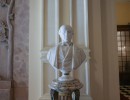On October 18, 1801, Justo José de Urquiza, a key figure in Argentine history, was born in Entre Ríos. He was governor of Entre Ríos and, later, the first constitutional president of the Argentine Confederation. An indispensable hero for the current structure of our country.
Urquiza was born in a ranch near Concepción del Uruguay, Entre Ríos, in what was then the Viceroyalty of the Río de la Plata. He spent his early years in the countryside, which would mold his character and his connection to the rural labors that would later drive the economic reforms during his governorship.
Urquiza began his education in Buenos Aires at the Colegio de San Carlos, although his formal education was cut short by the closure of the institution, which forced him to return to Entre Ríos and dedicate himself to commerce. This period allowed him to gain a growing influence in his community, which would lead him to play a key political role in the region. At the age of 25, he was already a deputy in the provincial legislature, where he presented innovative proposals to improve the administration, economy and education.
In 1832, his growing influence led him to be appointed general commander of the Second Main Department of Entre Ríos, a position of enormous power that allowed him to consolidate his leadership. After the departure of Governor Pascual Echagüe, Urquiza was elected as his replacement in 1841, marking the beginning of his outstanding political career.
Urquiza's years as governor took place in a turbulent period for the country, when civil wars between unitarios and federales were raging in the territory. Urquiza actively participated in these battles, defeating the eastern caudillo Fructuoso Rivera in 1845 and signing the Treaties of Alcaraz in 1846, which reaffirmed the Federal Pact of 1831.
One of the most decisive moments of his political life came in 1851, when he led the famous “Pronunciamiento de Urquiza”, a rebellion against the power of Juan Manuel de Rosas, who controlled the Argentine Confederation from Buenos Aires. Urquiza, supported by the provinces of Entre Ríos and Corrientes, together with Uruguay and the Brazilian Empire, formed the Great Army that defeated Rosas at the Battle of Caseros in 1852, putting an end to his government.
The next step was the promulgation of the National Constitution in 1853, a milestone that marked the political organization of the country. Urquiza was elected the first president of the Argentine Confederation in 1854, promoting important commercial treaties and encouraging immigration to colonize land. His government was highly influenced by the political and economic advice of Juan Bautista Alberdi. His government faced great challenges, especially the growing tension with the province of Buenos Aires, which culminated in the battle of Pavón in 1861, where Urquiza was defeated.
Despite his departure from power, Urquiza remained a central figure in the country's history until his assassination in 1870 in his residence at the Palacio San José. His legacy, as caudillo, governor and first constitutional president of the Argentine Confederation, is remembered as a leader who, with patriotism and vision, fought tirelessly for the unity and progress of the country. In the Hall of Honor, also known as the Hall of Busts of the Government House, there is a bust in his honor.

